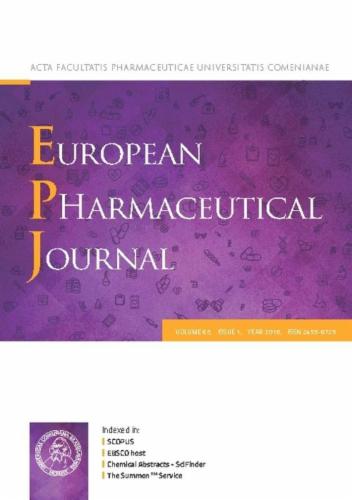在设计用于治疗牙周炎的多电解质络合物基膜时,如何继续进行易重结晶的塞硝唑?
IF 4.3
3区 医学
Q1 PHARMACOLOGY & PHARMACY
引用次数: 0
摘要
塞克硝唑是第二代5-硝基咪唑类药物,在治疗厌氧性牙周感染方面具有很大的应用潜力。本研究介绍了壳聚糖与果胶负电荷复合载药膜的制备过程。由于这种类型的接收系统的逐层技术的局限性,导致塞克硝唑在干燥阶段的自发结晶,开发了一种新的制备方法。为此,采用药物共结晶技术和两步干燥程序,以最大限度地减少溶剂蒸发过程中塞硝唑晶体的生长。通过视觉评估、机械强度测量和扫描电镜成像,选择最有前途的塞尼达唑-壳聚糖共晶负载膜进行进一步的物理化学(通过差示扫描量热法、傅里叶变换红外光谱、x射线粉末衍射、光学显微镜)和药物(体外释放、抗菌和肿胀试验)分析。观察了所利用的聚合物组成、多电解质复合物结构以及塞克硝唑形态(结晶/非晶)对薄膜性能的影响。干燥温度的提高提高了塞克硝唑与聚合物的混相性,从而改善了药物的负载,也显著延长了塞克硝唑在人工唾液中的释放时间。本文章由计算机程序翻译,如有差异,请以英文原文为准。

How to proceed with easily recrystallizing secnidazole in designing polyelectrolyte complex-based films for periodontitis treatment?
Secnidazole is a second generation 5-nitroimidazole with high potential for application in anaerobic periodontal infections therapy. In this study, the process of developing the drug-loaded films composed of oppositely charged chitosan and pectin for intra-pocket administration is presented. Due to limitations of layer-by-layer technique in receiving systems of this type, which resulted from spontaneous crystallization of secnidazole at the stage of drying, a new preparation method was developed. For this purpose, drug cocrystallization technique as well as two-step drying procedure were implemented in order to minimize secnidazole crystals growth during solvent evaporation. Through visual assessment, mechanical strength measurements and scanning electron microscopy imaging, the most promising secnidazole-chitosan cocrystals-loaded films were selected for further physicochemical (via differential scanning calorimetry, Fourier transform infrared spectroscopy, X-ray powder diffraction, optical microscopy) and pharmaceutical (in vitro release, antimicrobial and swelling tests) analyses. The impact of utilized polymeric composition and polyelectrolyte complex structures as well as secnidazole form (crystalline/amorphous) on the films performance was observed. The increased temperature of drying enhanced secnidazole-polymers miscibility, which resulted in desirable drug loading improvement and also significantly prolonged secnidazole release to the artificial saliva.
求助全文
通过发布文献求助,成功后即可免费获取论文全文。
去求助
来源期刊
CiteScore
9.60
自引率
2.20%
发文量
248
审稿时长
50 days
期刊介绍:
The journal publishes research articles, review articles and scientific commentaries on all aspects of the pharmaceutical sciences with emphasis on conceptual novelty and scientific quality. The Editors welcome articles in this multidisciplinary field, with a focus on topics relevant for drug discovery and development.
More specifically, the Journal publishes reports on medicinal chemistry, pharmacology, drug absorption and metabolism, pharmacokinetics and pharmacodynamics, pharmaceutical and biomedical analysis, drug delivery (including gene delivery), drug targeting, pharmaceutical technology, pharmaceutical biotechnology and clinical drug evaluation. The journal will typically not give priority to manuscripts focusing primarily on organic synthesis, natural products, adaptation of analytical approaches, or discussions pertaining to drug policy making.
Scientific commentaries and review articles are generally by invitation only or by consent of the Editors. Proceedings of scientific meetings may be published as special issues or supplements to the Journal.

 求助内容:
求助内容: 应助结果提醒方式:
应助结果提醒方式:


